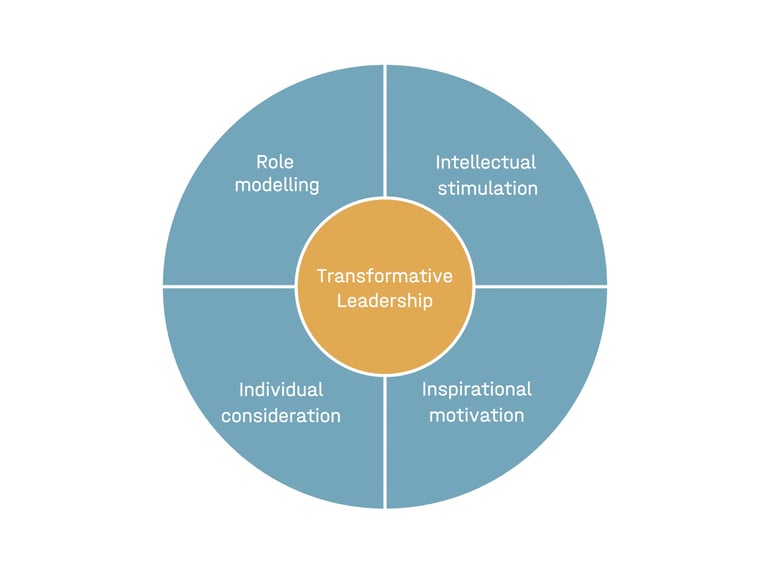- AJ Products IE
- Blog
- Leadership
- Transformative Leadership

Transformative Leadership
As a family-owned business operating in 21 markets, we are constantly working on our own leadership development. But we have also been working with entrepreneurs and business leaders for 50 years. So let us assist you with your workplace interior – and contribute to your understanding of healthy leadership, specifically, transformative leadership.
What is transformative leadership?
The theory of transformative leadership was developed in the late 70s by James MacGregor Burns and is built on the idea that an inspiring leader motivates employees to work towards collective goals. By building trust and serving as a role model, the leader fosters a safe work environment where each employee is encouraged to develop and improve their performance. MacGregor Burns stated that "leaders and followers help each other advance to a higher level of morality and motivation.”
Bernard M. Bass further developed the model in the 80s and formulated the four elements that can now be considered the foundation for the transformative leader:

The four elements of transformative leadership:
- Role modeling: the leader becomes a credible moral role model for the employees by setting a good example and living by their own values.
- Inspirational motivation: the leader presents clear visions and goals that motivate and inspire, helping employees see how they contribute to the bigger picture.
- Intellectual stimulation: the leader encourages employees to come up with their own ideas about what changes need to be made to achieve the set visions.
- Individual consideration: the leader shows a genuine interest in their employees and their goals. The leader also ensures that employees have the right skills to perform their job and thus feel motivation.
Motivation through self-determination theory
Self-determination theory (SDT) is a psychological theory about human motivation, well-being, and personal development and how these factors are affected by circumstances in our environment. It suggests that humans naturally strive to grow, develop, and function optimally. Self-determination theory focuses on three basic psychological needs: autonomy, competence, and relatedness. It also posits two fundamental types of motivation: intrinsic motivation and extrinsic motivation.
Combining the transformative model and self-determination theory is a good way to marry the four elements of transformative leadership and how to motivate your employees.

Transformative or pseudo-transformative leadership?
It can be hard to distinguish a transformative leader from a pseudo-transformative leader. As the model focuses on the leader not considering personal gain, personal characteristics are essential to the degree the leadership style is authentically transformative. Outwardly, it might seem like the pseudo-transformative leader is driven by an unselfish strive for the company's and employees' benefit, but it doesn't inherently mean the inner motivation, or goal, is the same.

Advantages and Disadvantages
As with all leadership theories, there are both positives and negatives about transformative leadership. It's not suitable for all employees or workplaces.
There are several advantages with the transformative leadership model, both on an individual- and organisational level:
- Increased engagement: transformative leadership can lead to higher engagement, work morale, and team spirit as it aims to empower and motivate employees.
- Enhanced creativity: by encouraging an open mind and creative thinking, transformative leadership can lead to new ideas and solutions.
- Improved work performance: transformative leaders can inspire employees to exceed their own expectations, which can result in enhanced performance.
Despite its many advantages, there can also be downsides to transformative leadership:
- Time-consuming: transformative leadership can be time-consuming as it requires the leader to be actively involved in each individual employee's development and objectives.
- Lack of structure: transformative leadership can lead to rapid change and lack of clear guidelines, which can create ambiguity, confusion, and stress for the employees.
- Risk of excessive optimism: transformative leaders can sometimes be overly optimistic and underestimate risks, which can lead to bad decisions and negative consequences.
Summary:
Transformative leadership, developed by James MacGregor Burns, is a leadership method where leaders and employees work together beyond their individual gains to create change and achieve collective goals. The leader's role is to engage, encourage, and empower their employees both as a group and individually. Transformative leadership is built upon four elements: acting as a role model, providing inspirational motivation, offering intellectual stimulation, and showing individual consideration.
FAQ
- Using transformative leadership is an efficient way to create engaged and thriving employees as the model encourages personal development and team spirit. Therefore, it suits most workplaces where there is room for such leadership. However, it's not a quick fix but a leadership style that needs continuous maintenance and long-term use.
- A transformative leader prioritises employees and focuses on highlighting their good qualities and promoting engagement. The transactional leader utilises rewards or punishments depending on how the employees perform their tasks.
- James MacGregor Burns (1918-2014) was an American historian, political scientist, and author who wrote several books, including the book “Leadership” which compiled his theories on leadership.
- Bernard M. Bass (1925-2007) was an American professor and researcher mostly known for his work within leadership research. At the time of his retirement, he was the most cited leadership researcher in the world.
- That the leader, in an encouraging and engaged manner, involves the employee in both their own development and the development of the operations.
- Developmental leadership is a leadership model that research-wise is based on transformative leadership. Both models are leadership styles focusing on creating positive changes within the organisation and promoting employee growth and development. Developmental leadership is the leadership model of the Swedish Armed Forces.
- The American psychologists Edward L. Deci and Richard Ryan.



